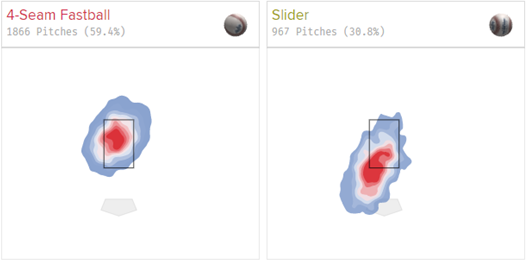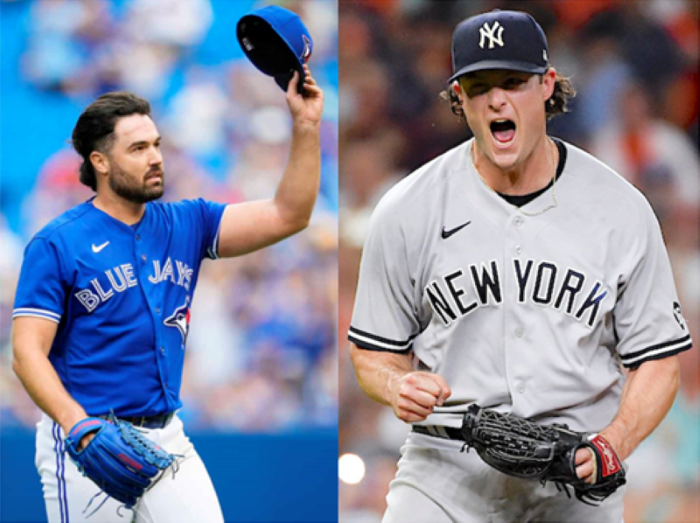If before the season someone told me that a Jays pitcher would be in contention for the Cy Young Award, I would have figured that Ryu – after finishing second the previous two seasons – was having a third go at it. However, what has really happened is something no one expected. The Cy Young race has come down to two pitchers, Gerrit Cole of the Yankees, and the Blue Jays’ very own, Robbie Ray. Cole is one of the best pitchers in baseball, so it is no surprise that he is one of the finalists for the American League Cy Young Award. Robbie Ray on the other hand, is not someone you would immediately think of as a Cy Young candidate when the season began, but he has had a career year.
When the Jays signed Ray to a 1-year, $8 million deal last offseason, it was seen as a nice pickup, and that he would be a good number three starter. Now looking back, however, this deal looked like the biggest steal of the offseason as Ray turned into the Jays’ ace. Ray led the league in innings pitched, ERA, and WHIP, and led all of baseball in strikeouts. One of the biggest challenges Ray has faced in his career was losing the strike zone and walking a lot of batters. In 2020, Ray had one of the highest walk percentages in baseball with 17.9%, but this season, he managed to drop it to a career-best 6.7%.
Ray was essentially a two-pitch pitcher as he threw 59.4% fastballs and 30.8% sliders. They say the best pitch in baseball is a well-located fastball, because when you can locate the fastball, you can build upon it, and it can make your secondary pitches more effective. Ray was able to have good command of his fastball and pound the zone for strikes with it. This allowed him to drop his hard slider, which would dart down and away to lefties, and down and in to righties.

The adjustments that Ray made to his delivery paid off in a big way this year, and now, he is likely to be rewarded with a lucrative contract this coming offseason.
Yankees ace Gerrit Cole also had an excellent season. He had an ERA of 3.23, a WHIP of 1.059, and a league-leading 16 wins. Like Ray, Cole is also heavily dependant on his fastball and slider as he throws them 47.1% and 22.2% of the time, respectively. However, he does throw his curveball and changeup more than Ray which can make Cole an even tougher matchup. He also throws harder than Ray, and he was often looked at as a bully on the mound because of it. Ray’s fastball ranges from 93.9mph to 97.2mph, whereas Cole’s fastball ranges from 96.7mph to 100mph. Due to the high velocity and spin rate of Cole’s fastball, he can throw it in any count and blow it by hitters and “bully” them with it.
Both Cole and Ray had tremendous seasons and the battle for the Cy Young Award went right down to the wire. They both have similar numbers and are neck-and-neck with each other in a wide variety of categories. There is no full proof system in determining a winner and each voter has their own deliberation process. Some may put more stock into ERA, whereas some may look at innings pitched and strikeouts – it’s subjective in this regard. Hall of Fame pitcher John Smoltz created a system that he believes can help determine the Cy Young Award winners.
The idea is that you look at all the data – or the data that you feel is most important – and give the players a score for each category. The score that is given to each player is based on where they ranked in their respective leagues, amongst qualified pitchers. Then, you add up all the scores and the player with the lowest score wins. This also allows you the opportunity to assign different weights to each category. If you believe that WHIP is more important than ERA, you can multiply the numbers by two, or whichever weight you want; this can be done for each category as you deem fit. This isn’t a foolproof way of deciding the Cy Young or other awards, but it can be used as a good template to see where the players rank and match up against each other.
| Player | IP | ERA | WHIP | BABIP | BAA | SO | SO/9 | BB/9 | K/BB | Total |
| Ray | 1 | 1 | 1 | 2 | 2 | 1 | 3 | 9 | 3 | 23 |
| Cole | 5 | 3 | 2 | 11 | 4 | 2 | 2 | 5 | 1 | 35 |
Based on this method, and the categories that I have selected, Ray is your Cy Young winner. For simplicity, I chose a handful of categories that I feel are important when evaluating a pitcher’s success and kept them at an equal weight. As you can see, Ray and Cole are in the top five in almost all of them, and Ray leads Cole in more of them.
Both players had fantastic seasons and were very instrumental to their team’s success. Cole was paid $324 million because he can put up Cy Young caliber seasons every year, and will likely be in contention for this award in the years to come. Ray has always had strikeout stuff, but has managed to put it all together this year for the best season of his career. Ray is the favourite to win the award, but it could go either way. We’ll see if Ray’s year shined bright enough to win him the Cy Young award, or if the Cole train steams towards his first, of perhaps many, Cy Young Awards.

